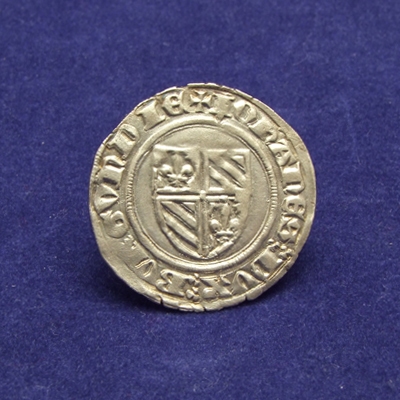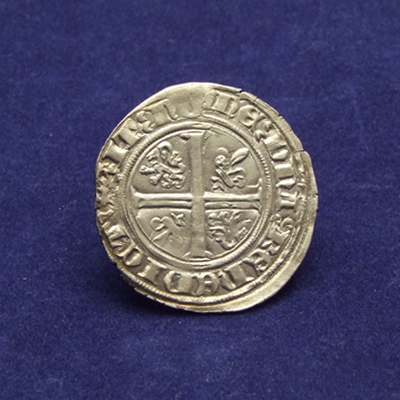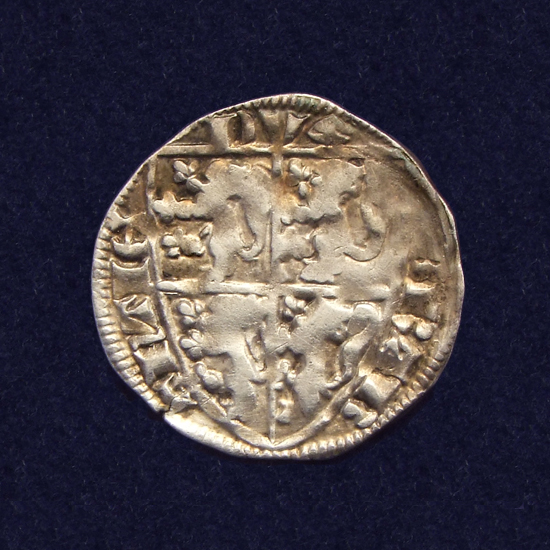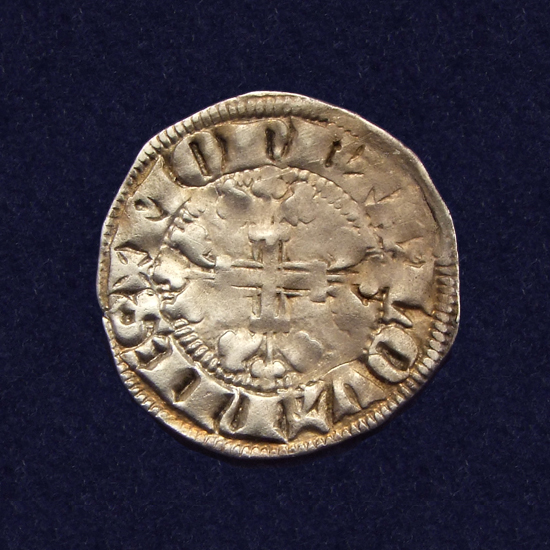Kings and monarchs
THE DUKES OF
BURGUNDY
Philip the Bold / Filips de
Stoute (1384-1404)
Philip the Bold, son of King Jean II of France was the founder
of the Burgundian dynasty. He received the Duchy of Burgundy from
his father as a reward for his courage at the Battle of Poitiers
(1356). He married Margaret, heiress of Louis of Male, Count of
Flanders. In 1384 he succeeded his father-in-law as Count of
Flanders, Artois, Nevers and Rethel. He always regarded himself as
a French prince, governed his vast realm from Paris and was seldom
in Flanders.
In contrast to the policy of coinage debasements of Louis of
Male, Philip the Bold restored the silver and gold contents in the
Flemish coinage (1389-1390).
In an effort to avoid the Duchy of Brabant to fall to
Luxembourg after her death, Joan of Brabant conferred all her
possessions on her niece Margaret, wife of Philip the Bold. Between
1384 and 1389 coins were struck under Joan and Philip the Bold
combined (Coinage Act between Brabant and Flanders of 16 July
1384). As a result of Philip's monetary offensive against Brabant,
Joan of Brabant ceded the Brabant coinage rights completely to
Philip in 1389. Philip allowed Jeanne to strike coins again
in 1392. On 1 October 1396, Jeanne ceded her privilege of mint to
the cities Leuven, Brussels and Tienen.
Philip the Bold died in Halle (Hainaut) on 27 April 1404, he
was succeeded by his son John the Fearless.
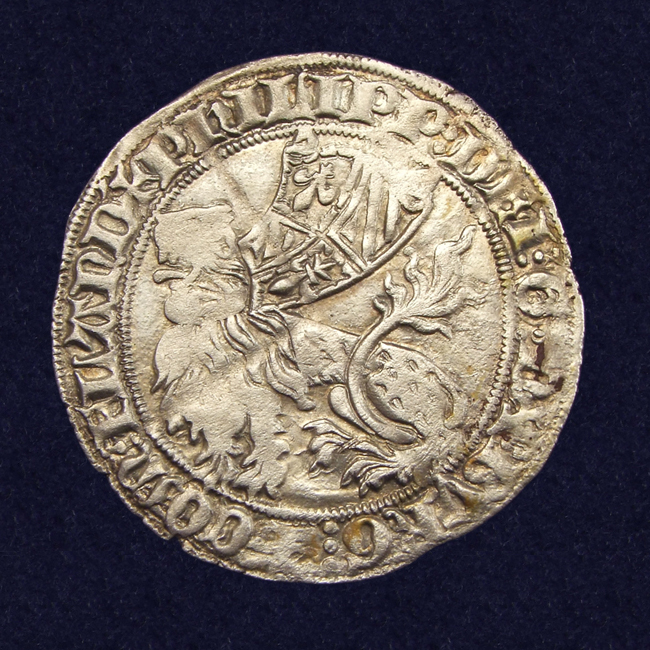
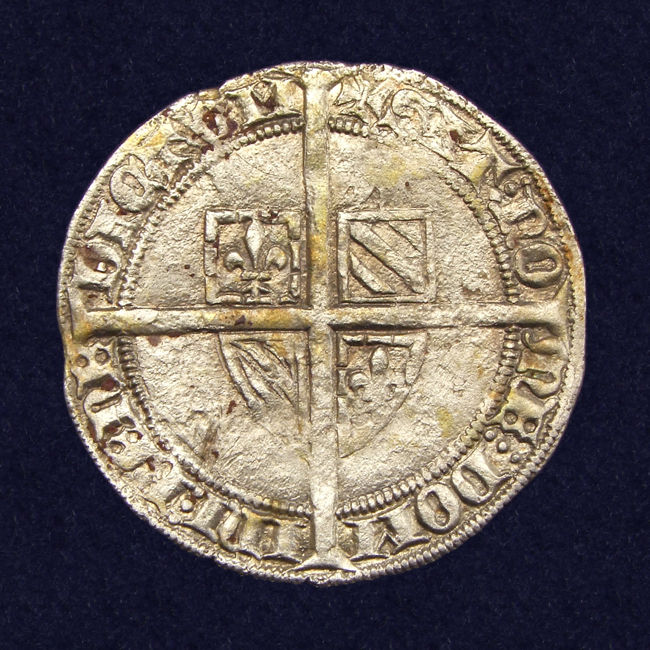
Dubbele groot
'Botdrager', struck in Flanders under Philip the Bold
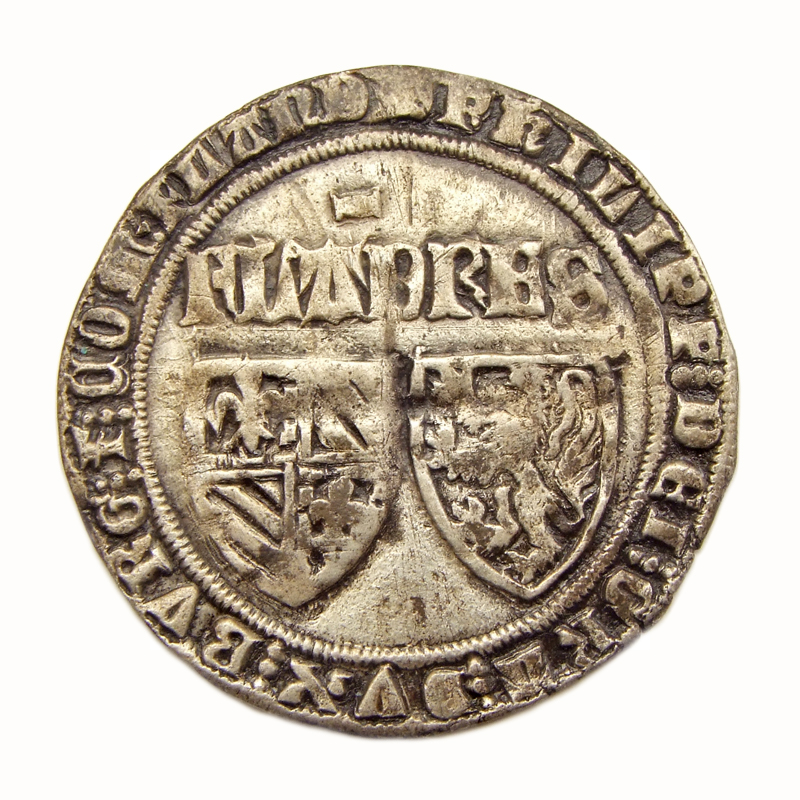
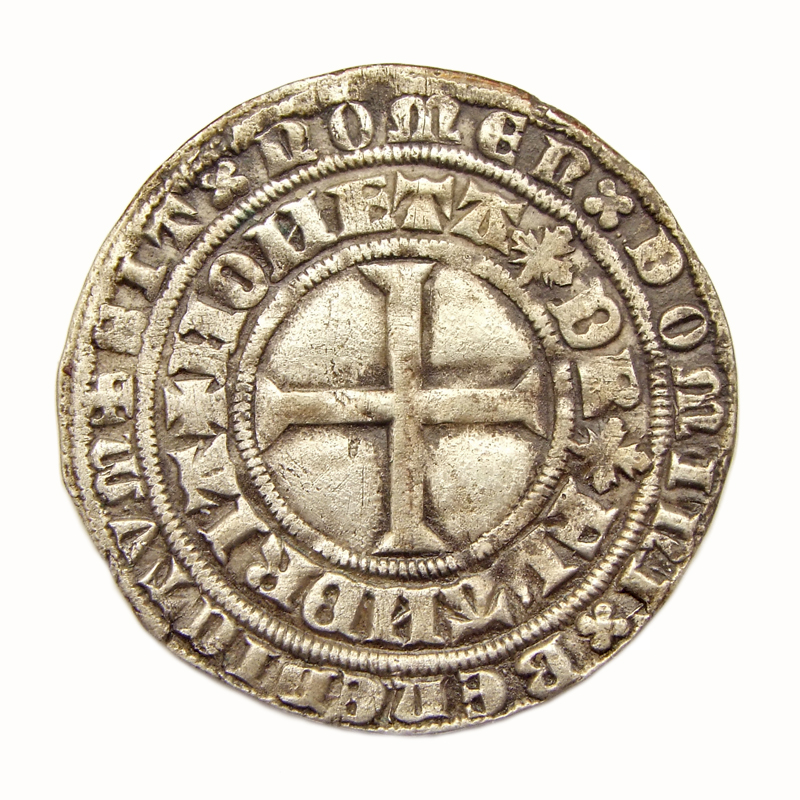
Dubbele groot
'Leliaard', struck in Flanders under Philip the Bold
|
John the Fearless (sans Peur)
(1404-1419)
John the Fearless, also called John II or Jan zonder Vrees was
Duke of Burgundy from 1404 to 1419. He fought against the Turks at
Nicopolis in 1396 where he distinguished himself on the battlefield
and earned his nickname 'the Fearless'.
He was a member of the Valois Dynasty and Regent for his
cousin Charles VI of France who was mentally ill. There was a power
struggle with the King's younger brother Louis of Orléans to gain
guardianship and control over the Dauphin. This struggle culminated
to the brutal assassination of Louis in the streets of Paris in
1407.
On 10 September 1419 John had a meeting with the Dauphin (the
future Charles VII of France) to discuss a peace treaty. The
meeting rook place on the bridge at Montereau where John was
assassinated by the Dauphin's companions.
John the Fearless introduced two silver coins during his
reign: the 'cromstaert' and the 'braspenning'. He maintained the
coat of arms from his father Pilip the Bold, but added an
inescutcheon: the arms of Flanders (small lion).
|
|
Burgundy, Grand
blanc
Struck under John
the Fearless as Duke of Burgundy (1409-1419)
|
|
Philip the Good
(1419-1467)
Philip the Good also known as Philippe le Bon or Philips de
Goede became Duke of Burgundy after the assassination of his father
John the Fearless (Jan zonder Vrees) in 1419. He was one of the
most powerful and influential rulers of the fifteenth
century.
In 1430 he created the Order of the Golden Fleece. For the
order he chose his personal emblem, the fire-steel in the shape of
“B” for Burgundy, placed two of them back to back and suspended the
fleece from a flint stone positioned between the fire-steels. This
emblem of the Golden Fleece and the Collar of the Golden Fleece has
been used on many coins since then, it is a very popular design on
Spanish coinage.
During his reign Philip tried to achieve a geographical unit
and greatly expanded his territories by acquiring Namur, Brabant,
Limburg, Hainaut, Holland, Zeeland and Luxemburg. To promote
commerce and the economic development of his territories Philip the
Good introduced a new and stable currency which he issued in 1434
for Flanders, Brabant, Holland and Hainaut (1st emission - Coinage
Act, January 23rd 1433). The new system was based on the groat of
Flanders and included the following coins:
- Gold coins: Goudrijder (Gold Rider or Cavalier d'or) and ½
Cavalier d'or
- Silver coins: Vierlander (double groat or patard), ½
vierlander (groat), ¼ vierlander (½ groat) and 1/8 vierlander (¼
groat)
- Billon coins: double mite and mite.
The name of the new silver coin 'Vierlander' refers to the
four countries where they were struck.
With the 2nd Emission (Coinage Act - June 11th 1454) Philip
introduced a new type gold coin: the gold lion.
The 3rd Emission (Coinage Act - May 23rd 1466) a uniform
manufacture of the Burgundian guilder was ordered. In 1496 it was
replaced with the St. Philippus guilder.
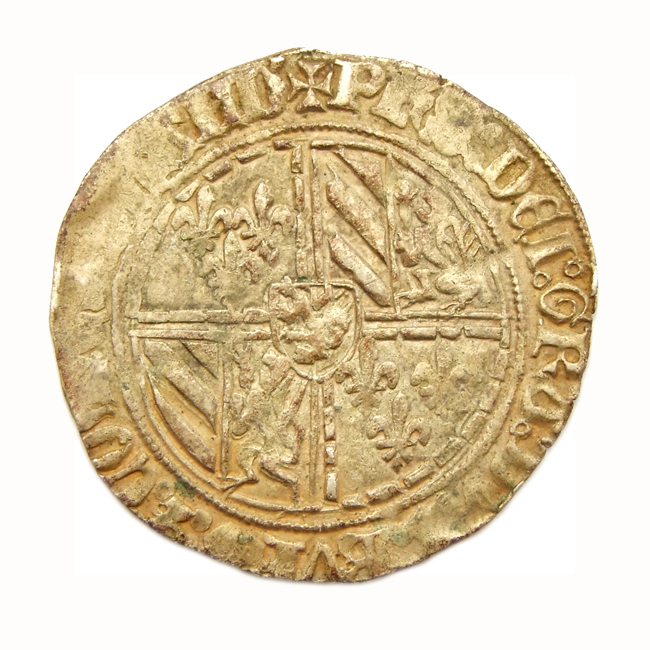 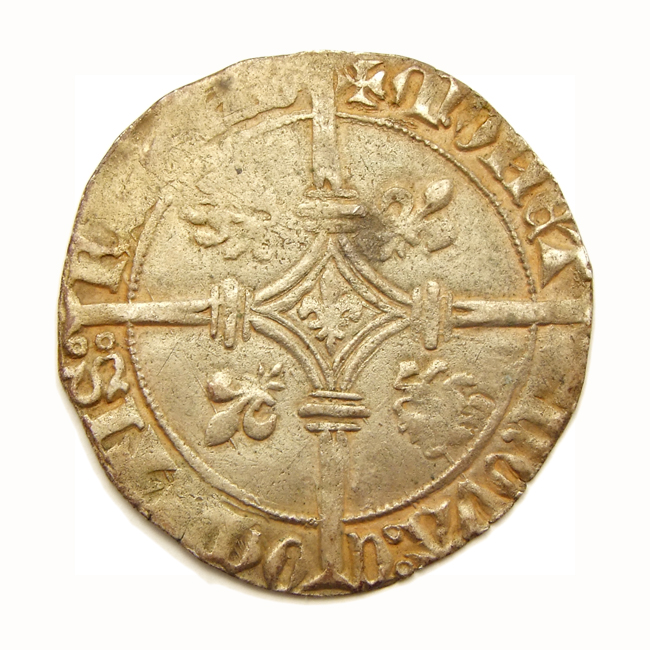 View a Vierlander, struck in Gent or Brugge
under Philip the Good under NumisAntica - Medieval coins
|
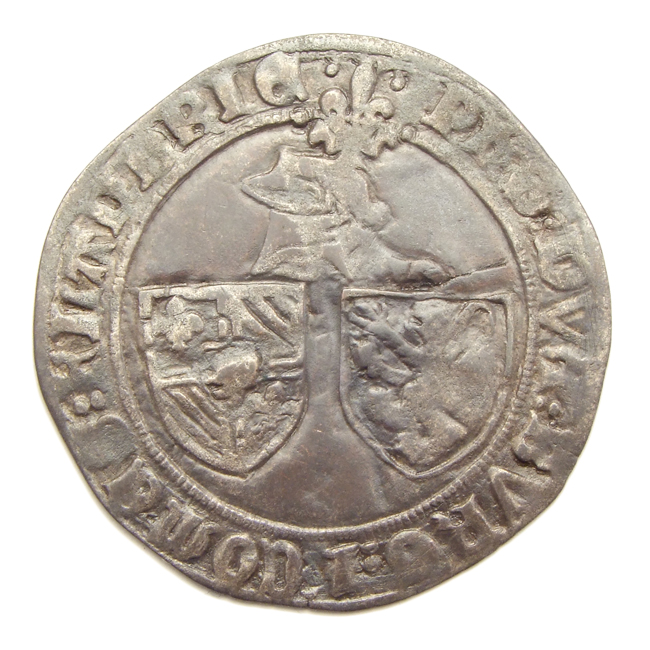 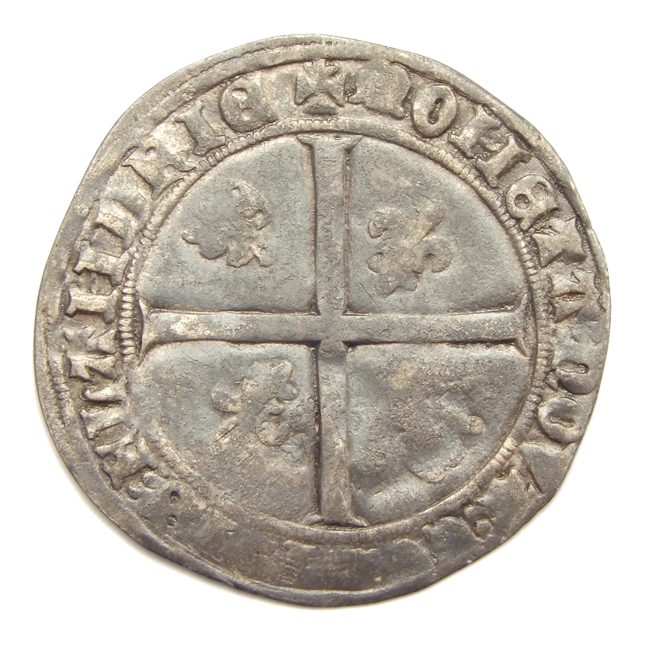 Example of a
Braspenning,
Struck under
Philip the Good between 1421-1433
|
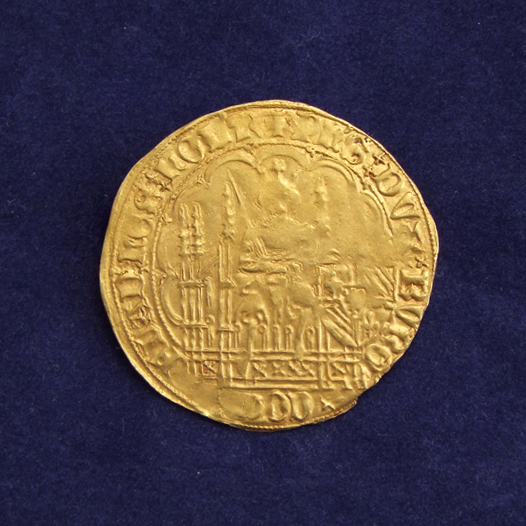 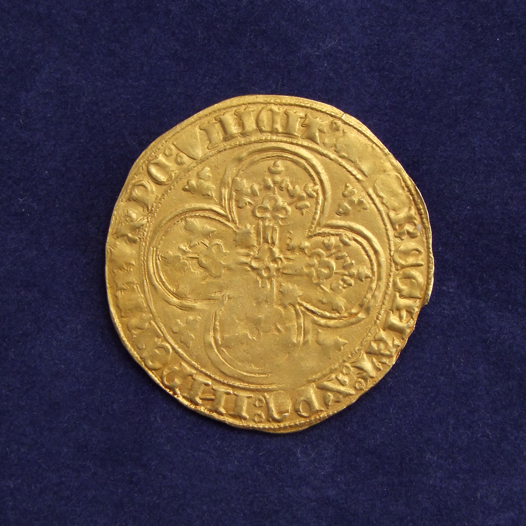 Example of "Gouden
Schild", struck under Philip the Good as regent (1425-1428),
Holland
|
Mary of Burgundy
(1477-1482)
Born in 1457, Duchess of Brabant, Limburg, Lothier, Luxemburg
and Guelders and Countess of Flanders, Artois, Charolais, Hainaut,
Holland, Zeeland and Zutphen.
Mary was the only daughter of Charles the Bold and
granddaughter of Philip the Good. As the heiress to the vast and
wealthy Burgundian domains in France and the Low Countries she was
often referred to as "Mary the Rich". Mary ascended upon her
father's death in the Battle of Nancy on January 5 1477. On 16
August 1477 she married Archduke Maximilian of Austria. To entice
the Low Countries into providing support against the French King,
Brabant was granted its 'Joyous Entry' and Holland and Zeeland
their 'Great Privilege".
In 1482 she died after a fall during a hunt. Her son succeeded
her as Philip IV of Burgundy (Philip the Handsome) under the
guardianship of his father.
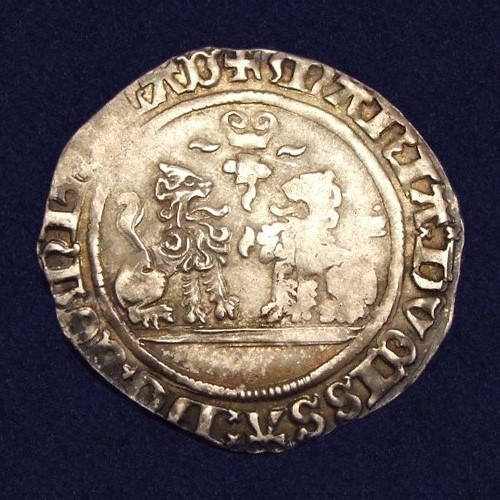
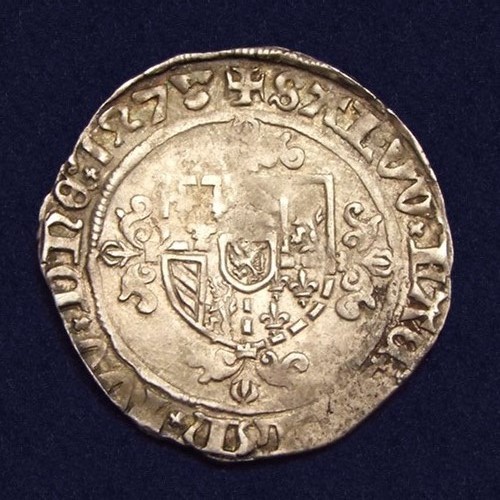
Example of a
Double briquet (dubbel vuurijzer), struck under Mary of Burgundy in
Bruges 1478.
|
Philip the Handsome or the Fair
(1478-1506)
Philip the Handsome or Philips de Schone was the first
Habsburg King of Castile. The list of his regnal titles also
included (among others) Count of Flanders and Holland, Duke of
Burgundy and Brabant. He was the son of Maximilian I, Holy Roman
Emperor, and Mary of Burgundy. In 1496 he married Infanta Joanna of
Castile.
He introduced 2 new gold coins: the "St. Philippus goudgulden"
with a value of 24 stuivers and in 1496 the "Gouden vlies" or
"toison d’or" which had a value of 50 stuivers.
|
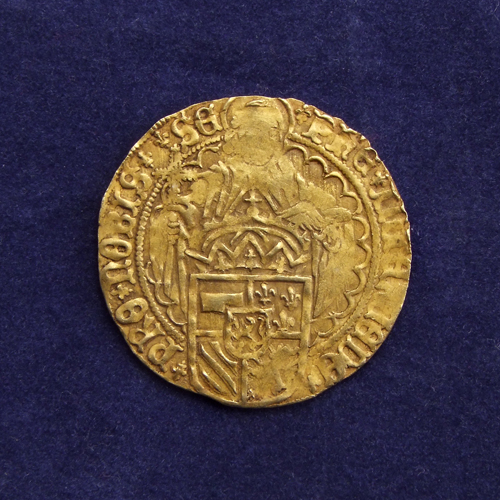 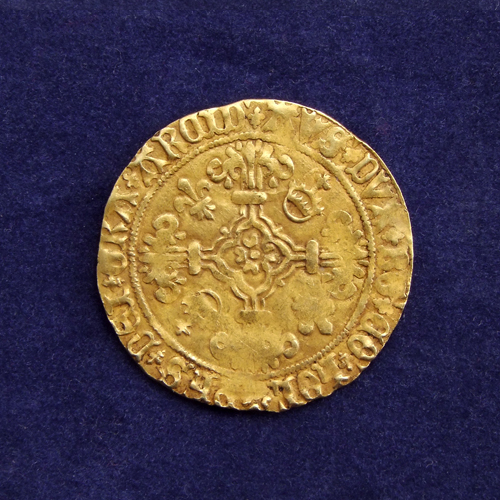 Example of a St.
Philippus goudgulden, struck in Dordrecht between
1499-1506
|
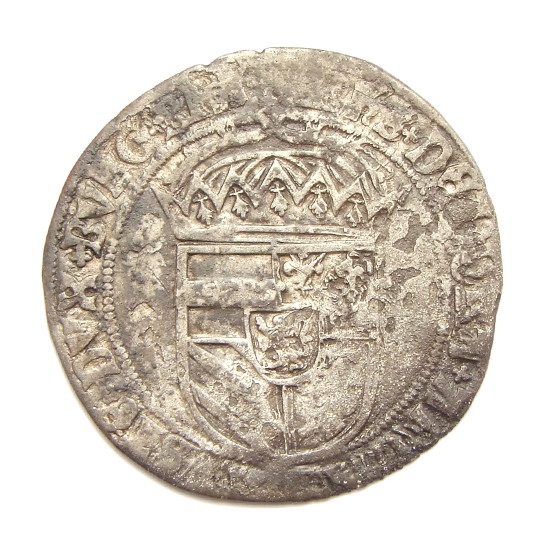 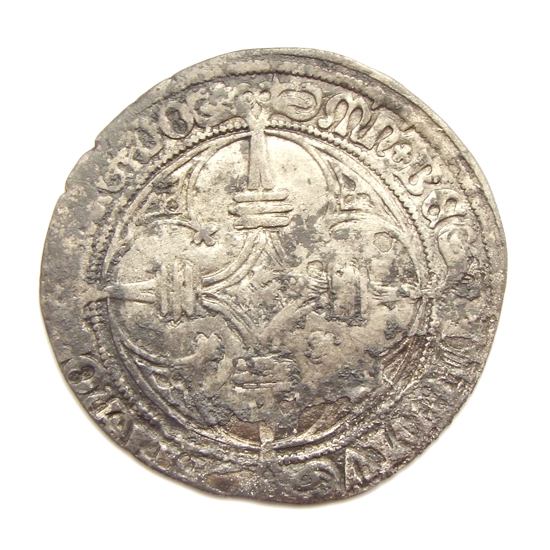 Brabant, double
stuiver, struck under Philip the Handsome
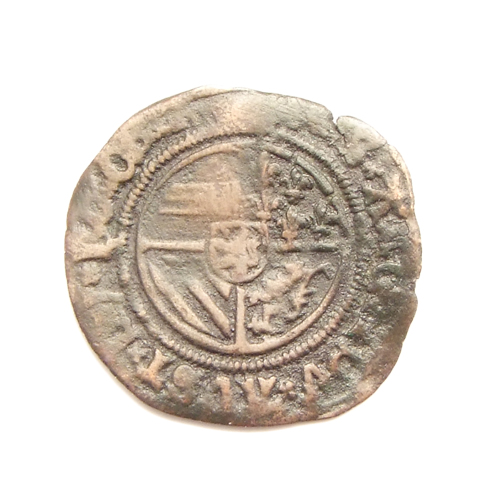 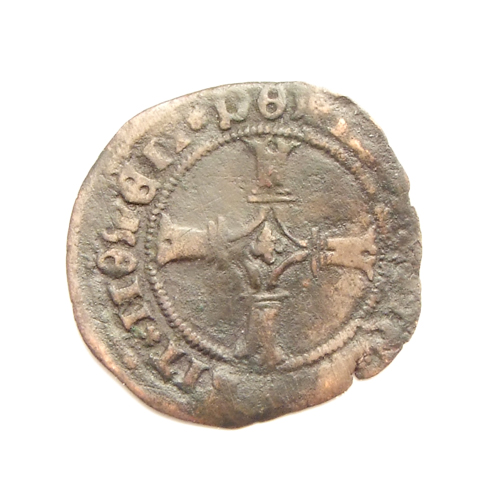 Vlaanderen,
dubbele mijt, struck 1499-1506 under Philip the
Handsome
|
DUKES OF BRABANT
Jan I of Brabant
(1267-1294)
Jan I of Brabant (1251/1253 - 1294), also called John the
Victorious was Duke of Brabant (1267-1294), Lothier and Limburg
(1288-1294). He was the son of Henry III, Duke of Brabant and
Aleidis of Burgundy, daughter of Hugh IV, Duke of Burgundy. He
earned his nickname the Victorious after his greatest military
victory, the Battle of Woeringen (June 5 1288) after which he
gained the Duchy of Limburg. John I is often referred to as a modal
of a feudal prince and was very popular in poetry and literature.
He was very fond of participating in tournaments and jousts. On 3
May 1294 he was mortally wounded during festivities at Bar-le-Duc.
He was buried in Brussels, but his tomb has been destroyed during
the Beeldenstorm in 1566.
Since 1266-1270, the French gros tournois was very popular in
France, and circulated in its surrounding lands. Many countries
soon started to strike their own imitation of this type. Initially,
the English sterling was imitated for 1/3 gros. In 1285 the gros
tournois was imitated, but to a lower standard than the original
French type.
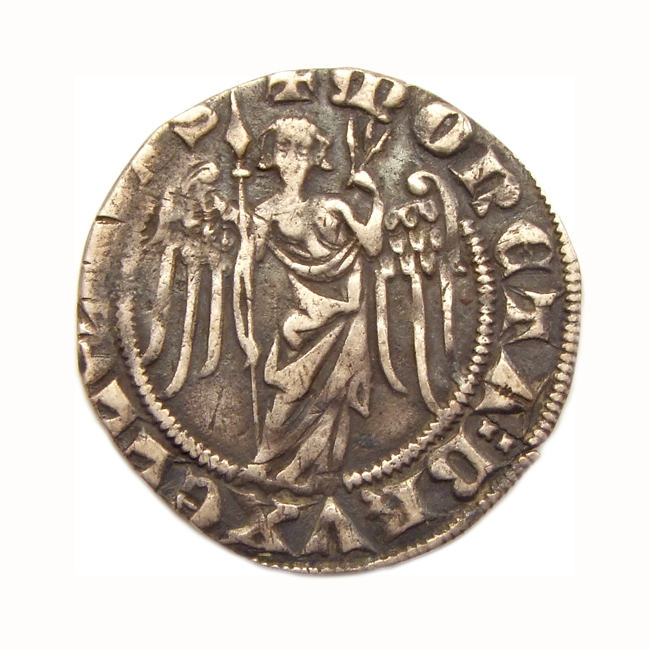
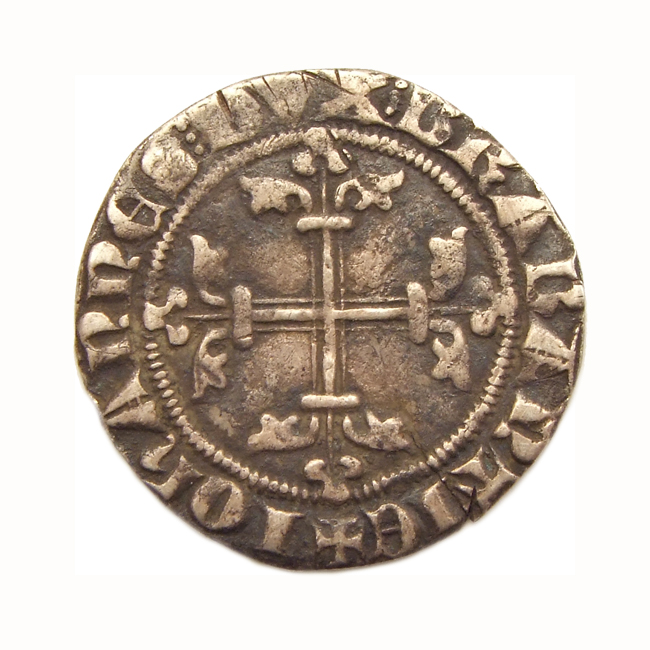
Brabant, Brussel,
2/3 Groot (Engelengroot), struck under John I
(1268-1294)
Jan III of Brabant (1300
– December 5, 1355, Brussels), also called Jean or John III, the
Triumphant, was Duke of Brabant, Lothier, and Limburg (1312–1355).
He was the son of John II, Duke of Brabant and his wife Margaret,
daughter of King Edward I of England.
During his reign, Jan III became a powerful lord, alternately
supporting France or England. He initially supported Edward III of
England with his claim for the French crown during the first stages
of the Hundred Years' War (1337-1345), betrothing his second
daughter Margaret to Edward, the Black Prince. As his alliance with
England unravelled, Brabant was retained as an ally by France with
a treaty, signed at Saint-Quentin in 1347. His daughter Margaret
was now to marry Louis of Male, Count of Flanders.
While his father Jan II protected a large number of Jews in
his castle of Genappe and allowed them to establish banks; under
Jan III they fared less better. The majority of Jews were victims
of the 'Black Death' persecutions. In Louvain, all the Jews were
delivered to the flames (1349 and 1350).
Jean III was granted the right to strike gold coins by Emperor
Louis of Bavaria. In the Ordinance of 9th January 1336 Jean, agreed
with Guillaume I of Holland and Hainaut to manufacture a coin that
would circulate in the lands under their respective sway. To
accomodate trade between Flanders and Brabant, an agreement was
made with Count Louis I of Flanders to mint coins in Gent and
Leuven.
After his death Jan III was buried in the Cistercian Abbey of
Villers (now in Belgium). His sons having predeceased him, he was
succeeded by his daughter Joanna.
View on
NumisAntica - Medieval coins: AR Sterling, struck in Leuven
1330-1337 under John III
KINGS OF FRANCE
|
Philip IV (1285-1314)
A member of the House of Capet, Philip was the son of King Philip III and Isabella of Aragon. He ascended the throne at age 17. In 1294 hostilities broke out between the French King and his
brother-in-law, Edward I, King of England. He also suffered a major
military defeat in Flanders. For the first time in recorded
history an army of footsoldiers (Flemish) defeated an army of
knights (French army) in the Battle of the Golden Spurs
(Goudensporenslag) near Kortrijk on 11 July 1302. The large numbers
of golden spurs that were collected from the French knights gave
the battle its name. The date of the battle is still the official
holiday of the Flemish community in Belgium.
During his reign Philip had to search for income to cover
these military expenditures and finance his royal budget. He levied
heavy taxes on the French clergy, expelled the Jews from France,
aniihilated the order of the Knights Templar and debased the
coinage. His grandfather had minted a few gold coins (Ecu), but
under Philip there was a mass diffusion of gold coinage. Hence his
nickname le roi "faux monnayeur", meaning "King
counterfeiter".
|
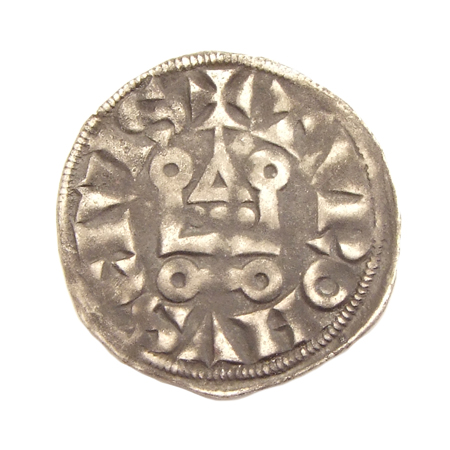 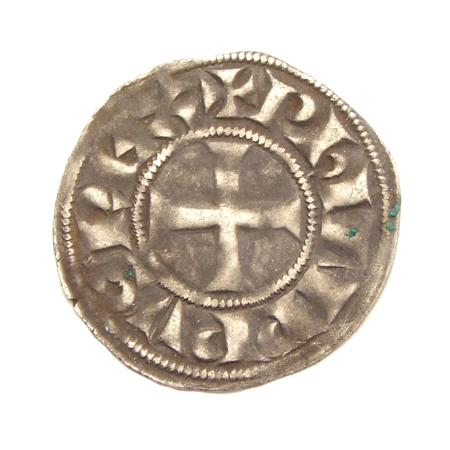 France, Denier
Tournois, struck between 1285-1290 under Philip IV
|
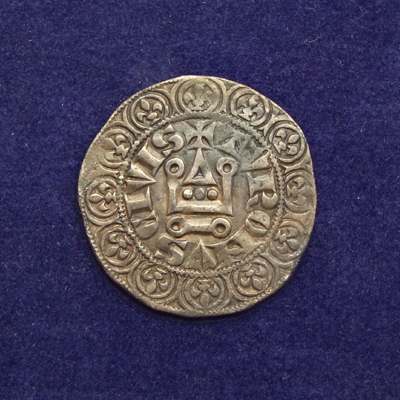 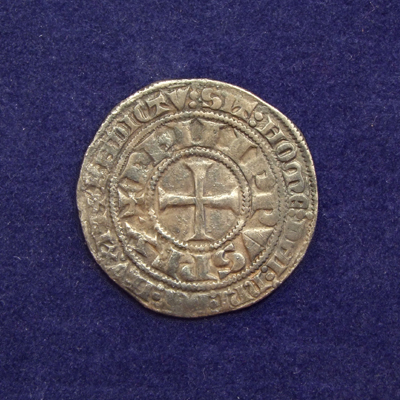 France, Gros
Tournois (undated), struck between 1290-1295 under Philip
IV
|
|
Charles VI (3 December
1368 – 21 October 1422), called the Beloved (le Bien-Aimé) and the
Mad (le Fou). In 1380 he came to the throne as a member of the
House of Valois.
Charles experienced mental ilness in 1392 which plagued him
throughout his life. This resulted in major feuds as his uncles
(the Duke of Burgundy and the Duke du Berry) and his brother
(Louis, Duke of Orleans) struggled for power; and seriously
weakened the French position during the Hundred Years' War. Charles
VI (as did more French kings) found alternative ways to finance the
war: sales taxes and debasing the coinage.
After the death of Charles VI in 1422 both his son (Charles
VII) and his grandson (Henry VI of England) were proclaimed King of
France. Charles VI appears to have passed on his mental illness to
his grandson Henry, whose inability to govern led England to
another civil war, known as the Wars of the Roses.
|
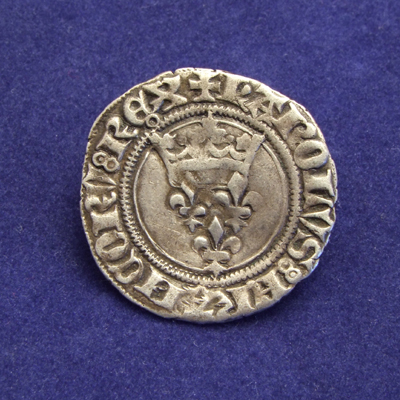 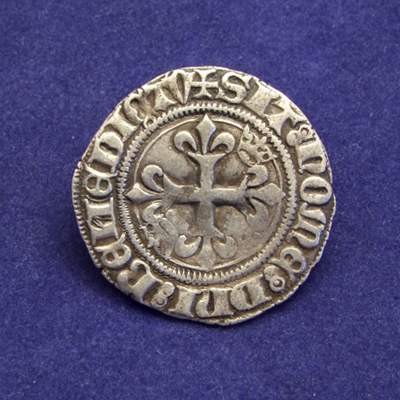 France, Florette,
struck under Charles VI between 1380-1422 (2nd Royal Emission,
Paris)
|
COUNTS OF HAINAUT (GRAAFSCHAP
HENEGOUWEN)
|
Joan (Johanna or Jeanne) and
Margaret of Constantinople were the daughters of Count
Baldwin IX of Flanders (also Count Baldwin VI of Hainaut) and of
Marie of Champagne. He was one of the most prominent leaders of the
Fourth Crusade which resulted in the capture of Constantinople and
the foundation of the Latin Empire. He was crowned as the First
Emperor of the Latin Empire in Constantinople on 16th of May 1204.
After he vanished in 1205, his daughter Joan succeeded as Countess
of Hainaut and Flanders. Apart from two known coins (denarius and
obole), struck under Reginar V (1013-1030), medieval minting in
Hainaut commenced under the rule of Countess Joan.
After the death of Countess Joan, her sister Margaret
succeeded her as Margaret II, Countess of Flanders and Hainaut
(1244-1280). She remained Countess of Flanders until 1278 and
Countess of Hainaut until her death in 1280.
To facilitate trade, around 1270 Marguerite of Constantinople
ordered her mints to issue imitations of the "gros tournois," the
heavy silver coin that King Louis IX of France had first issued in
1266. The original portrait on the obverse of the gros tournois was
retained, but the reverse was replaced by an armored rider
(ridder). Hereby the first introduction of a rider was made in
Western European coinage.
|
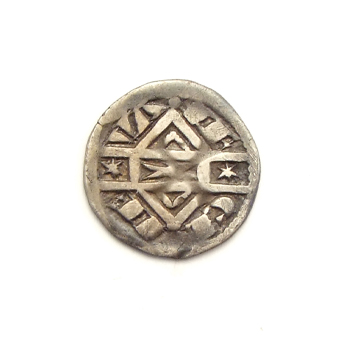 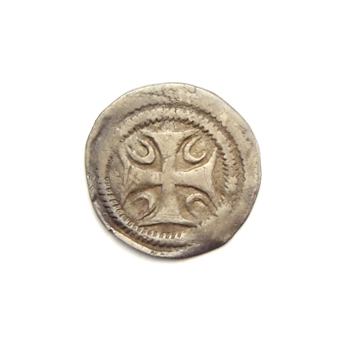 AR Maille,
Valenciennes mint.
Struck under Joan
of Constantinople
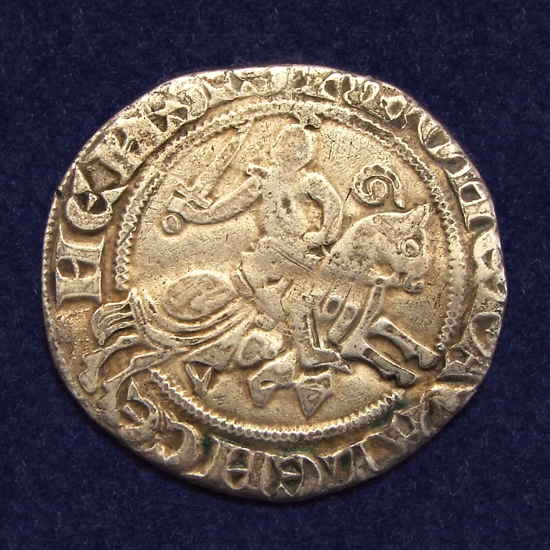 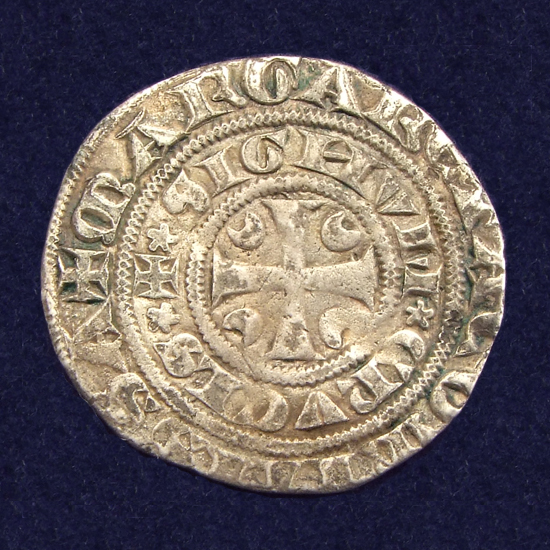 2/3 Ruitergroot,
struck in Valenciennes under Margaret of
Constantinople
|
|
William I, Duke of Bavaria,
Count of Holland, Hainaut, Zeeland was the second son of
Emperor Louis IV and Margareta of Holland and Hainaut. After the
death of his father in 1347, William struggled with his mother
Margaret for possession of Holland, Zeeland and Hainaut. This
struggle was the start of a civil war (the Hook and Cod wars)
which would last 140 years. (1350-1490). With the help of King
Edward III of England, the first clash was successful for Margaret
(naval battle off Veere in 1351), but the Battle of Vlaardingen was
disastrous. In 1354 William was recognized as Count of Holland and
Zeeland. Margaret remained Countess of Hainaut untill her death in
1354. In 1357, William began to show signs of insanity. A year
later his brother Albert became Regent of Holland and Hainaut.
William was confined for the rest of his life. He died in Le
Quesnoy in 1389. His brother Albert then succeeded him as Albert I,
Duke of Bavaria, Count of Hainaut, Holland and Zeeland.
|
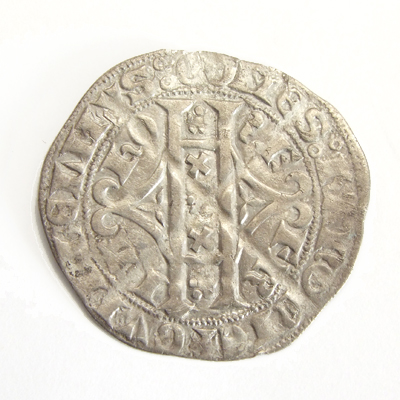 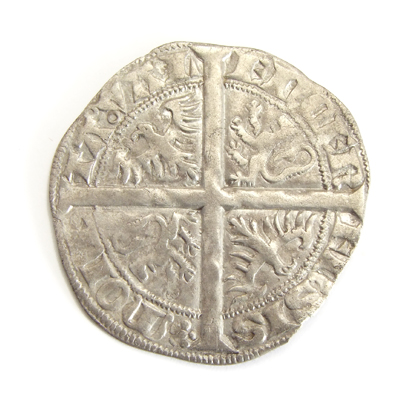 Double groat,
stuck under William the Mad (1356-1389)
|

